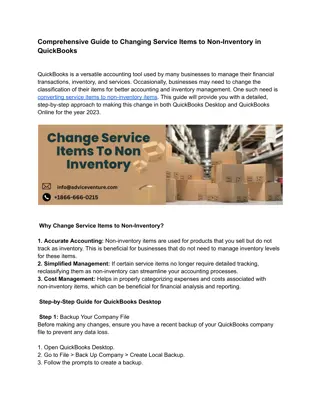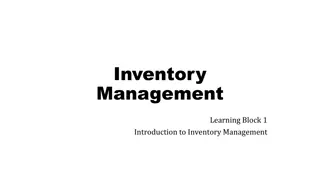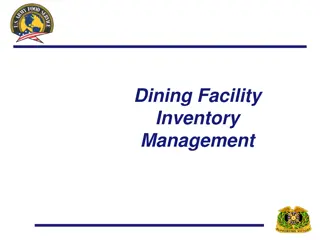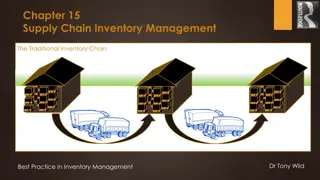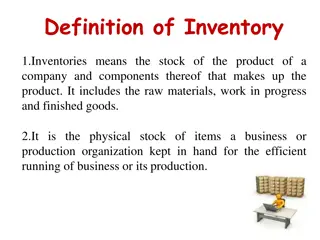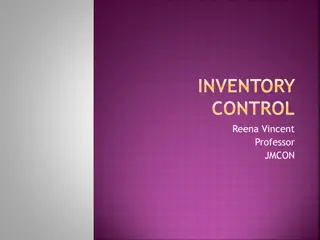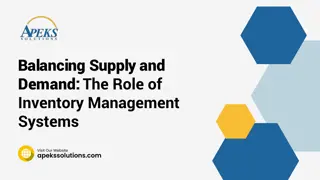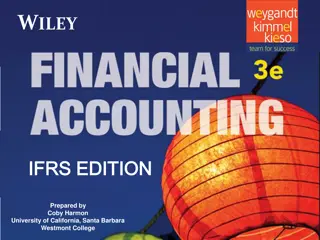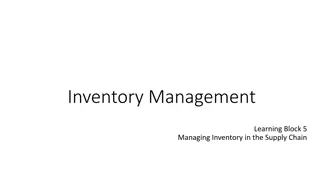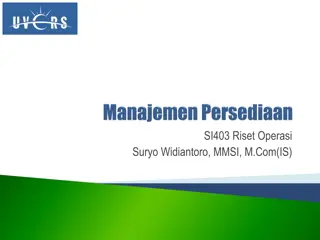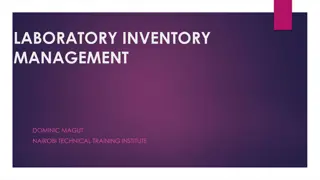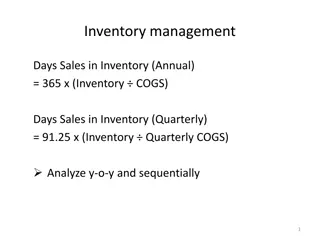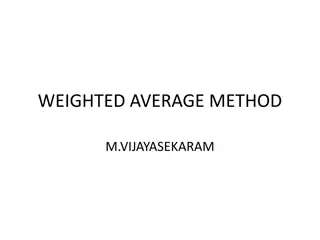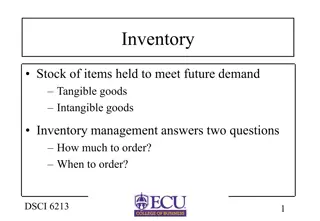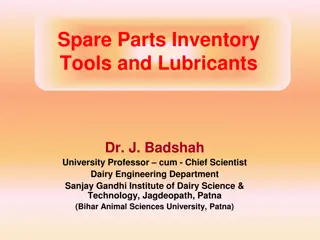Comprehensive Guide to Inventory Management Principles
Inventory management is crucial for efficient store operations. Learn about the art of managing stock, maintaining optimal levels, and the key principles guiding inventory management. Explore how to manage the right quantity, quality, time, source, and price of inventory, along with the procurement process. Take your inventory management skills to the next level with this detailed guide.
Download Presentation

Please find below an Image/Link to download the presentation.
The content on the website is provided AS IS for your information and personal use only. It may not be sold, licensed, or shared on other websites without obtaining consent from the author.If you encounter any issues during the download, it is possible that the publisher has removed the file from their server.
You are allowed to download the files provided on this website for personal or commercial use, subject to the condition that they are used lawfully. All files are the property of their respective owners.
The content on the website is provided AS IS for your information and personal use only. It may not be sold, licensed, or shared on other websites without obtaining consent from the author.
E N D
Presentation Transcript
INVENTORY MANAGEMENT -AFA TRAINING IRIFM
INTRODUCTION Inventory management is an art of management of stores. Stores comprise of materials which are held in stock The stocking of materials not only occupy space in the depot but also blocks the capital If is the stock that is maintained in excess of the requirement It means blocking up of the capital.
Stock and Inventory management If the stock is maintained at a minimum level it will hamper the maintenance. So it is therefore required to maintain the stock at an optimal level This optimum level maintenance is done by using the technique of Inventory Management.
PRINCIPLES OF INVENTORY MANAGEMENT Inventory management depends on FIVE principles: MEN The persons involved in the process MATERIAL The correct quantity and prescribed quality required MANAGEMENT It is the planning , organizing and controlling of Inventory Management MACHINERY MONEY The process or procedure involved in Machinery The availability of Budget
AIM OF INVENTORY MANAGEMENT Right Quantity: It is the right or correct quantity that is required to be procured. It is given by the formula NPQ = ??? 2 CP + IP + BS SIH + CD WHERE ; NPQ Net procured quantity AAC- Average Annual Consumption made in the last year CP-Covered Period IP-Interim Period BS- Buffer stock held SIH- Stock in hand CD-Covered Dues
RIGHT QUALITY The right quality will have to be assisted by the technical team which will be certified RIGHT TIME The time of delivery is crucial as the time is the essence of the contact. RIGHT SOURCE The right source of supply will matter like DGS and D , GeM , DLW , CLW etc RIGHT PRICE This has to be done on the basis of LAR or Market value/Survey
PROCUREMENT PERIOD The inventory management will start right from the time the tender is floated till such time the material is received and stocked and issued to the consuming department. This will revolve round the following 1. The Officer Purchasing the material 2. The User department 3. The Depot Officer 4. The Finance Officer 5. The Consignee
Why Inventory management/Control? The Daily stores comprise of STOCK AND NON STOCK Items. STOCK ITEMS NON-STOCK ITEMS These are stores which are required to be stocked caused by constant demand These are the stocks which are required urgently and not stocked for a specific purpose The indents are vetted by HQRS These indents are vetted by Associate Finance Once vetted , Finance will be available Once vetted , the finance will be limited to the current year. Chargeable to capital Chargeable to Revenue Bill passing by HQ/ stores Bill passing by Associate Finance
2. The procurement of huge stores means blocking up of capital , and has to be managed efficiently , thus it is also known as capital management. 3. The procurement of stores for remunerative works must be prioritized so that they will start earning revenue. 4. Since the overstocking of material means blocking up of capital and dividend payable to GR , the concept is no more in vogue.
FACTORS AFFECTING INVENTORY MANAGEMENT FACTORS AFFECTING INVENTORY MANAGEMENT 1. LEAD TIME : 5. Change in Purchase Policy of the Government The time taken from the date of processing the tender of Release of PO , Procurement , stocking and Issue to be kept in mind 2. Proper Planning 6. Multiple purchase and Staggered purchase affecting the purchase Proper planning has to be done so that the stock does not go below the minimum level 7. Overstocking of Surplus stores / Obsolescence / Wastage / Leakage / Pilferage 3.Availability of Raw materials 4. Market Condition 8.Non-Availability of funds
Two categories of surplus MOVABLE SURPLUS DEAD SURPLUS When these stores are not required and there is no likelihood of consumption even after 24 months . They will be forced to the consuming department or transferred to other Railways or other department or put on sale . In the absence of the above they will be assessed by the survey committee they will be prepared in lots and put up to Auction. These are the stores which have been issued for a period of 24 months and there is a likelihood that they will be used in the near future . The materials are due to obsolescence , sudden fall in consumption level , change in design or pattern and return from the user
OBJECTIVES OBJECTIVES 6.Ensuring supplies are made in the most economic , efficient and Expeditious manner 1.Ascertaining the needs of the user department 2. Preparation of correct estimates of quantity to Purchase of stores/ Manufacturing stores. 7.Suggesting user department to go for indigenous supply 8.To promote the trial order/educational order 3.Maintaining economic level of investments. 4.Obtaining desired quantity at competitive rates. 9.Regular touch with market and supplier 5.Receipt , Inspection , Stocking and distribution
INVENTORY MANAGEMENT ANALYSIS TECHNIQUES INVENTORY MANAGEMENT ANALYSIS TECHNIQUES ABC/XYZ(Depends on Annual Consumption) ALWAYS BETTER CONTROL VED (Depends on level of consumption) VITAL ESSENTIAL DESIRABLE FSN (Depends on level of consumption) FAST SLOW NON MOVING HML (Depends on level of consumption) HIGH MEDIUM LOW GOLF (Depends on purchase policy) GOERNMENT ORDINARY LOCAL FOREIGN SDE SCARCE , DESIRABLE , ESSENTIAL SOS (Depends on Problems faced) SEASON AND OFF-SEASON
ABC ANALYSIS ABC ANALYSIS A Category items comprise of very sensitive whose consumption levels are indicated below and are to be reviewed at HOD level CATEGORY OF ITEMS ITEMS AS PERCENTAGE OF STOCK VALUE A CATEGORY 10% OF ITEMS @ 70% OF STOCK VALUE B CATEGORY 20% OF ITEMS @ 20% OF STOCK VALUE C CATEGORY 70% OF ITEMS @ 10% OF STOCK VALUE B category items at JAG level C category items at Depot level.
Thus , ABC analysis can be combined with VED , FSN , HML and SDE A B C 1.High Consumption 1.Medium Consumption 1. Low consumption 2.Requires HOD level 2.JAG monitoring 2.Stores Depot level 3.Strict Control 3.Medium Control 3.Less control 4.Frequent purchases with staggered delivery 4.Purchasing minimum stocks for safety 4.High safety level 5.Strict Follow up 5. Follow up for 3-6 months 5. Follow up needed Every Year 6.Accurate Planning 6. Moderate Planning 6. AAC 7.Multiple Sourcing 7. Develop Reliable source 7.Local supplier 8.Critical value examination to avoid wastage 8. Moderate Analysis 8.Annual review
Inventory turnover Ratio Inventory Turnover Ratio is an index of performance of Material Management Department. It is calculated by dividing the Closing balance of inventory by Issues during the year It is calculated separately with fuel and without fuel. Lower the Ratio better the health of Inventory Management of a Railway or vice versa.
Inventory turnover Ratio Stores balances mentioned in the calculation of Turnover Ratio comprise of Stores in Stock Stores in Transit Purchase Suspense Sales Suspense Stock Adjustment Account
IMPROVE SUSPENCE BALANCE 1. To have an effective Turn over ration , we should reduce the purchase burden A) 1.Over-stocks: To be managed in most efficient way 2. In-Active items should be weeded out : Specially focus on D1 and D2 items stocked 3. Surplus stores to be got rid of B) Review of Active Items a)Drawal of stores through AAC b)Sufficiency of stocks c)Monitoring the supplies d)Altering the quantity as per option clause
C)Dropping purchase proposal D)Disposal of Scrap E)Inter depot transfers F)Inter Railway transfers G)All suspense balance to be closed effectively H)Departmental and accounts stocks verification TURN OVER RATIO =??????? ??????? ?100 ????? ?????? = ????? ??????? ?? ????? ?? ???? ?????? ??? ???? X100 ????? ????? ?????? ??? ????
Conclusion Inventory is money spent and locked up. Better inventory management results in large scale economy and improved turnover ratio. New methods of purchase like GeM, e procurement, reduced stock levels by placing more items in Rate contracts would lead to economy in purchases Continuous monitoring at higher levels help a lot in this area.
Turn Over Ratio - Practical 1.Calculate Turn Over Ratio of ABC Railway as on 31.03.2022 from the data given below: Total Issues during the FY 2021-22 = 5000 Stores in Stock as on 31.03.2022 - Debit = 700 Stores in Transit as on 31.03.2022 - Debit= 5 Purchase Suspense as on 31.03.2022 - Credit = 20 Sales Suspense as on 31.03.2022 - Credit = 10 Stock Adjustment Account as on 31.03.2022 - Debit = 75
Turn Over Ratio - Practical Turn Over Ratio Formulae Stores Balances as on 31st March / Total Issues during the year x 100 = 700+5-20-10+75 / 5000 x 100 = 750/5000 x 100 = 15 %






